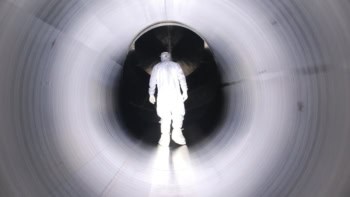
A long-standing disparity between different measurements of the cosmic expansion rate might be explained, at least in part, by the existence of a “mirror world” containing copies of all known particles. That is the conclusion of three physicists in the US, who have shown how to reconcile contrasting values of the Hubble constant obtained from observations of the nearby and distant universe. Their scheme involves recalibrating the size of the universe without altering other cosmic parameters, but they caution that more research is needed to understand exactly how light and matter interacted at the dawn of time.
The Hubble constant is one of the most important parameters defining cosmic evolution. It tells us how quickly galaxies fly apart from one another – and therefore how fast the universe is expanding. For years, however, its value has been in dispute. Measurements of distances and speeds of objects in the local universe consistently yield a higher value than those that infer the expansion rate from cosmological data. Most notably the cosmological value inferred from fluctuations in radiation known as the cosmic microwave background (CMB), which was generated when electrons and protons combined to form neutral hydrogen atoms a few hundred thousand years after the Big Bang.
That disparity has now reached a statistical significance of 5σ, which means that the disagreement is unlikely to be a chance fluke. Recently, Adam Riess at the Space Telescope Science Institute in Baltimore, US, and colleagues have established a Hubble-constant value of 73.04 ± 1.04 km/s per megaparsec (Mpc) via local observations. Meanwhile, data from the CMB, courtesy of the European Space Agency’s Planck satellite, instead yield 67.49 ± 0.53 km/s/Mpc.
This disagreement could potentially be explained away by the existence of systematic errors in the measurements, but no such errors have been identified. As a result, many researchers are looking for holes in cosmological theory and new physics.
Rescaling parameters
In the latest work, Francis-Yan Cyr-Racine of the University of New Mexico and Fei Ge and Lloyd Knox of the University of California, Davis propose a new strategy for revising the standard cosmological model while still retaining consistency with the numerous planks of observational evidence supporting it. Their idea is to rescale certain parameters to bring the data from the CMB in line with that from local observations of the Hubble constant, but to do so while preserving cosmological observables’ internal consistency or “symmetry”. These observables include all distance ratios, CMB temperature anisotropies and CMB polarization.
As the trio points out, a similar idea had already been put forward by Oliver Zahn and Matias Zaldarriaga back in 2003. But that work involved rescaling just one parameter – Newton’s gravitational constant – and was unable to preserve symmetry in certain cases such as small angular scales. The new research relies on rescaling at all times both the cosmic expansion rate and the rate of photon scattering (crucial for the generation of the CMB), which in turn rescales the lengths and timescales needed to shift the Hubble constant. In this way, say Cyr-Racine and colleagues, symmetry breaking is zero under the ideal conditions of equilibrium recombination and zero neutrino mass while it is “mild” in real-world conditions.
One straightforward way of rescaling the universe’s expansion rate would be to increase the energy density of all particles in the cosmos, both matter particles and force carriers. Doing so, however, would also affect the CMB’s mean energy density, which has been established very precisely using data from NASA’s COBE satellite. Instead, the researchers propose that the universe contains what is known as a mirror world dark sector.
Dark particles
Already extensively studied by particle physicists looking to understand why gravity appears so much weaker than the other known forces, the mirror world would contain copies of all existing fundamental particles. These would interact with each other through “mirror” versions of the known force particles, albeit having different masses and coupling strengths. The existence of both “dark baryons” and “dark photons” would allow for a higher matter density while simultaneously preserving the well-measured baryon-to-photon ratio and remaining consistent with the COBE data (which would otherwise be contradicted by too many visible photons). The presence of “dark neutrinos” would in turn conserve the existing proportions of free-streaming to tightly-coupled particles.
Doing the sums, the trio concludes that this mirror world could deliver the re-scaling needed to eradicate the Hubble constant inconsistency. However, they have not so far enjoyed similar success when it comes to rescaling the rate of photon scattering. They say that this could in principle be done by altering the ratio of helium to hydrogen but have found that the revised number conflicts with the amount of helium and deuterium that is thought to have existed in the early universe.

Finding a consistent constant
They point to some possible solutions to this problem. Boosting the photon scattering rate, they say, could perhaps be achieved either by altering the spectrum of photons in the high-energy tail of the CMB or by stipulating that electrons’ mass varies in time. The abundances of light elements, on the other hand, could conceivably be modified by introducing new kinds of interaction between the light and dark sectors.
But the researchers do not intend to try and overcome this obstacle on their own. As they put it, they have “provided clear model-building targets for the community to explore”.
Radek Wojtak, a cosmologist at the University of Copenhagen in Denmark, says that the new proposal bears a “quite intriguing” resemblance to conformal transformations – the idea that the laws of physics remain fixed even when units are changed. But he argues that introducing a new transformation and a new species of particle to solve just a single anomaly is “quite a big investment”. He is also concerned about the absence of any new perspective on dark energy, which, he says, “is currently the most challenging part of the standard cosmological model”.
The research is described in Physical Review Letters.



